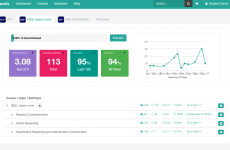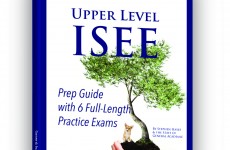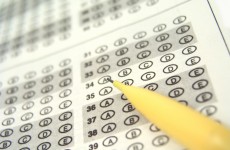The Education Records Bureau’s (ERB) ISEE features three levels: Lower Level (Applicants to 5th and 6th grade), Middle Level (Applicants to 7th and 8th grade), and Upper Level (Applicants to 9th, 10th, 11th, and 12th grade). The structure of each test is the same. However, time limitations and the difficulty of the material are dependent on the level of the test and are grade-level appropriate. The first four sections are multiple-choice with four answer choices for each question. The Essay is not scored, but it is sent to all schools designated by the student on the registration form. The Verbal and Quantitative Reasoning sections test a student’s abstract reasoning skills while the Reading Comprehension and Mathematics Achievement sections test a student’s content knowledge.
Structure of the ISEE (Upper Level)
| Test Section | Time Limit | Content Area / Skills | # Questions |
| Verbal Reasoning | 20 Minutes | Synonyms | |
| Sentence Completions | |||
| TOTAL | 40 Questions | ||
| Quantitative Reasoning | 35 Minutes | Arithmetic/Algebra/Geometry | |
| Concepts/Understanding | |||
| Applications/Higher-Order Thinking | |||
| Quantitative Comparison | |||
| TOTAL | 37 Questions | ||
| Reading Comprehension | 35 Minutes | Humanities | |
| Science | |||
| Social Studies | |||
| TOTAL | 36 Questions | ||
| Mathematics Achievement | 40 Minutes | Knowledge and Skills | |
| Computation / Comprehension | |||
| Arithmetic/Algebra/Geometry | |||
| Applications | |||
| TOTAL | 47 Questions | ||
| Essay | 30 Minutes | 1 Prompt |
What to Expect on the ISEE
The Verbal Reasoning section tests the student’s ability with vocabulary and vocabulary application. The first twenty questions are Synonyms questions that require the student to not only know the definition of the capitalized vocabulary word but also the definitions of each answer choice. The last twenty questions are Sentence Completion questions that test the student’s ability to apply one’s knowledge of vocabulary in the context of a sentence. The sentence will have either one or two blanks and the student must select the answer choice that best fits into those blanks.
The Quantitative Reasoning section, perhaps the most difficult, also features two parts: word problems and quantitative comparison questions. The questions in both sections vary in amount of work, regularly requiring little to no actual calculations in order to answer the question. The student is tested on one’s ability to reason through information and one’s comprehension of math theorems and rules. The quantitative comparison questions present two quantities and ask the student to determine the quantities’ relationship to one another (or if it can even be determined).
The Reading Comprehension section features passages from various fields and subjects, including pieces on scientific concepts, historical information, and poetry. The questions following each passage include main idea, supporting idea, inference, vocabulary, organization/logic, and tone/style/figurative language questions. These questions test the student’s ability to understand themes and concepts within each passage, know definitions of words within a particular context, and to draw conclusions from content not explicitly stated in the passage.
The Mathematics Achievement section tests a student’s ability to solve questions concerning Numbers and Operations, Algebra, Geometry, Measurement, Data Analysis and Probability, and Problem Solving (according to standards by the National Council of Teachers of Mathematics). As opposed to the Quantitative Reasoning section, students may need to do calculations to solve the questions in the Mathematics Achievement section and students will need to be familiar with mathematical terminology. For measurement conversions, students do not need to have memorized conversions in the U. S. standard system. Conversions are normally given in questions that require them, but conversions within the same unit in the metric system are not.
The Essay gives a student the chance to demonstrate to the schools how well the student can organize one’s thoughts and convey an argument or statement within a short essay in response to a prompt. The prompt is grade-level appropriate, and the student will be able to answer the prompt pulling from one’s experiences and education. The student will have two pages of lined paper on which to write the essay and must use an ink pen. The student may write the essay in cursive or print.
ISEE Highlights
- 1 point is awarded for each correct answer in all sections
- There are no deductions for incorrect answers (answer all questions!)
- The student is not allowed a calculator for the math sections
- Students are not provided scratch paper—all work is to be done on the test booklet
- Students may only take the ISEE once every six-months
- Students must take the ISEE at an approved facility with a licensed proctor
- Generally the student will take the ISEE at the student’s most desired school
- The ISEE features four scores:
- Raw score – the total number of correct answers in each section
- Scaled score – a reflection of the raw score in a scaled format from 760 to 940
- The ERB uses various versions of the ISEE each year and the scaled score has the same meaning across all versions of the test, as opposed to the raw score
- Percentile rank – the student’s standing in comparison to the norm group
- Percentile ranks range from 1 to 99. A percentile rank of 75 in Verbal Reasoning would mean the student scored better than 75 percent of the norm group
- The norm group is all students in independent schools in the same grade who took the ISEE over the last three years throughout the nation
- Stanine score – ranging from 1 to 9, stanines reflect segments of the percentile rank
- Stanine of 1 to 5 reflects percentile ranks 1 to 59
- Stanine of 6 reflects percentile ranks 60 to 76
- Stanine of 7 reflects percentile ranks 77 to 88
- Stanine of 8 reflects percentile ranks 89 to 95
- Stanine of 9 reflects percentile ranks 96 to 99
Further Reading
Excerpted from General Academic’s publication, “Houston Private & Select Public Schools: Survey, Analysis, and Research, 3rd Edition.”


























Pingback: Overview of the High School Placement Test (HSPT)